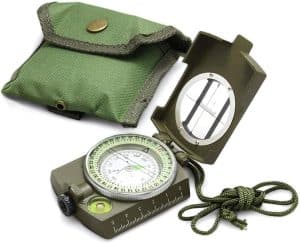If you’re in a rush, I’ll save you some time by recommending the Suunto MC-2G. It’s incredibly reliable and my personal daily driver.
Going hiking? Then you NEED a compass. There’s no ifs, ands, or buts about it!
Your trusty compass will get you out of a pinch when your phone or GPS device dies. Or, when you get lost and don’t know which way to point the map. In dozens of situations, this tool could be a literal life-saver, and it costs about the same as a six-pack of beer.
But, how do you find the best compass for hiking? That’s where I come in…here are the best compasses we recommend for hiking:
- Suunto MC-2G Compass (Best Compass Overall)
- Eyeskey Compass (Most Durable Hiking Compass)
- TruArc 3 Compass (Best For Beginners)
- Coghlan’s Map Compass (Best Budget Option)
- SUUNTO A-10 Compass (Best Minimalist Hiking Compass)
Table of Contents
ToggleBest Compass For Hiking: Our Top Picks
Suunto MC-2G Compass
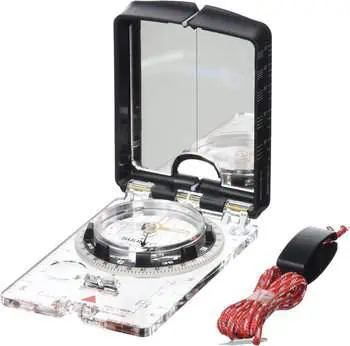
Type: Analog | Increments: 2 degrees | Dimensions: 3.9 x 2.5 in | Weight (oz): 2.6 oz
Suppose you’ve already read my hiking watch buying guide. In that case, you’re likely already familiar with the benefits of Suunto products. Despite not having the flashiest aesthetic, the Suunto MC 2G is the compass I use most often for a few reasons.
First off, the compass’ card-like shape makes it super portable since you can easily fit it into even the tightest of pockets. I’m not one to wear skinny jeans often, but if I were, I’d pick the MC-2G.
Another less-fashionable reason to go for this compass is that it’s precise no matter where you are in the world. Why? Because its declination adjustment tool (more on that later) gives you accurate directions everywhere.
Finally, its luminous rotating bezel (otherwise known as an azimuth ring) also makes this compass a breeze to read in the dead of night.
The extra sighting hole is handy too, but it isn’t a massive determinant for casual campers who need it for everyday use.
Lastly, it’s not a game-changer, but the built-in strap helps me carry it without any fuss.
All these factors put together make this my #1 pick.
Pros:
- Portable card-like form
- Reliable even under magnetic variation
- Luminous rotating bezel for nighttime use
- Extra sighting hole
- Built-in strap
Cons:
- Aesthetic isn’t as flashy as other products
Best for: campers looking for a reliable compass that don’t mind basic designs.
Eyeskey Compass
Type: Analog | Increments: 1 degree | Dimensions: 4.56 x 3.46 x 1.92 in | Weight (oz): 8 oz
If the Suunto MC 2G is your performance-centric OnePlus Nord, then this survival compass from Eyeskey is the Samsung Galaxy Note20 Ultra. You know, the type of product that tells you form and function aren’t mutually exclusive.
It comes in both green and black, which realistically covers most color preferences in the hiking world. I’m not sure about you, but I can’t recall the last time I saw a purple hatchet being used anyway.
Aside from the aesthetics, the construction of this lensatic compass is absolutely on point with the aluminum alloy chassis.
It’s also waterproof, so you could keep this in your pocket while wading through the waters without having to worry about any damage occurring.
The dial is luminous, and the bezel rotates freely. Therefore, the reading experience is obviously top of the line with this survival compass (commonly referred to as a military compass).
While it’s not exactly a con, you should note that the phosphorescent material on the bezel takes a while to charge before it glows. Don’t expect the compass to shine bright if it’s spent the entire day inside your backpack, since it hasn’t been exposed to enough light.
Pros:
- Great design
- Two color options
- Aluminum alloy chassis for maximum durability
- Waterproof
- Luminous rotating bezel
Cons:
- Some buyers have had issues with magnetic declination
Best for: campers who need a lensatic compass that can take a beating and still look good as new.
TruArc 3 Compass
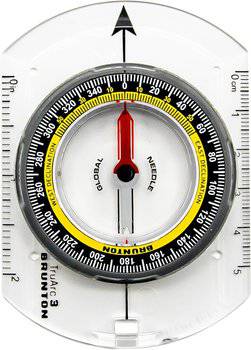
Type: Analog | Increments: 2 degrees | Dimensions: 6.69 x 2.6 x 0.75 in | Weight (oz): 1.1 oz
If you’ve just come from my hatchet breakdown article, you know that we love products that are made in the USA. The TruArc 3 is our recommendation for patriots trying to keep their shopping domestic.
Besides being made in the USA, why would you want this compass? For one, its bare-bones design makes it a good pick for beginners looking to build up their navigation skills without being overwhelmed by a more complex interface. Some newbies even use this as a learner compass before upgrading to a more advanced compass like the Eyeskey or something similar.
Despite being “born in the USA,” the TruArc 3 is still friendly to foreigners as it has both inch and centimeter scales. This feature slipped under my radar until my friend from London came along on a camping trip. We got to joke about the metric/US measurement systems and had a good laugh.
Beyond its versatility, I’m a big fan of the form that this compass sports. It weighs just over a single ounce and has absolutely minuscule dimensions of 2.5″ x 3.5″ — almost equal to a standard credit card.
Pros:
- American-made
- Simple design makes it easy to use and a good learner compass
- Imperial and metric scales
- The size of a credit card
Cons:
- No cardinal directions on top of the bezel
Best for: rookie navigators who want something small and straightforward to get them in the groove.
Coghlan’s Map Compass
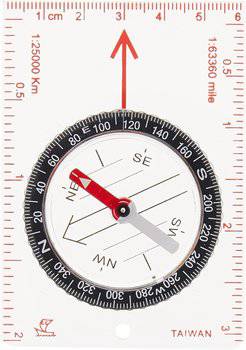
Type: Analog | Increments: 1 degrees | Dimensions: 4.5 x 3.1 x 0.9 in | Weight (oz): 1 oz
Next up, we have the map compass from Coghlan’s.
This particular model is well known for being an affordable compass option. I’ll tell you right now that most campers don’t use this as their main compass. It’s generally more of a backup that they carry around.
It might seem excessive to own a second compass, but there’s no real downside since they cost so little, and weigh even less. If you lose or break your primary compass, then having a contingency plan ensures you won’t get lost.
The entire base is see-through, making it the perfect compass for map reading since it doesn’t obstruct any information. Couple the semi-transparent chassis with the magnifying lens, and you’re all set.
Its pointer is luminous too, which means that navigating at night won’t be an issue. If your current compass doesn’t glow in the dark, then assigning the Coghlan’s as your nocturnal navigator would be wise.
However, this model is pretty susceptible to interference from ferrous objects, so take note of that.
Pros:
- Very cheap compass
- Semi-transparent chassis and magnifying lens help you read maps
- Serves as an excellent backup compass or nocturnal navigator
- Comes with a nylon cord for easy carrying
Cons:
- Vulnerable to interference from ferrous metals
Best for: campers looking for an affordable secondary compass.
Check Price at Sportman's Warehouse
SUUNTO A-10 Compass
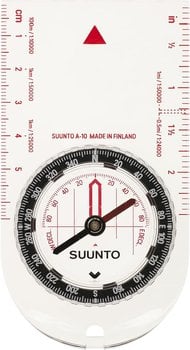
Type: Analog | Increments: 2 degrees | Dimensions: 4.09 x 2.2 x 0.39 in | Weight (oz): 1.6 oz
We started this article off with a Suunto compass, so it seems only fitting that we close off with one too. This baseplate compass comes in an even more compact package since it doesn’t have a plastic shroud with a sighting mirror on top, yet still retains the card shape of the MC-2G.
Despite its spartan aesthetic, the construction of this compass is actually quite impressive. The magnetized needle is made out of high-grade steel. It has a high-quality jewel bearing, so you won’t have to worry about it not being durable enough. It’s essentially the iPhone 20-XR-z (does that exist yet?) of compasses.
Its snap-lock lanyard attachment point is a subtle feature, no doubt, but one that I like a lot. This makes it so easy to pop the strap off when you want to use the compass to read your map.
Another small feature I liked is that unlike other liquid-filled compasses, this one had no bubbles. This is a nice touch, giving me confidence in its accuracy.
The main drawback is that this isn’t a global compass like the first Suunto model we looked at. It’s only balanced in the Northern Hemisphere, so those south of the equator may want to look for another compass.
Pros:
- Even more compact than the Suunto MC-25
- Durable components
- Has a snap-lock lanyard attachment point
- Bubble-free
Cons:
- Not suitable for use in the Southern Hemisphere (sold separately)
Best for: north-of-the-equator campers looking for a durable, compact compass.
How To Choose The Right Compass For You
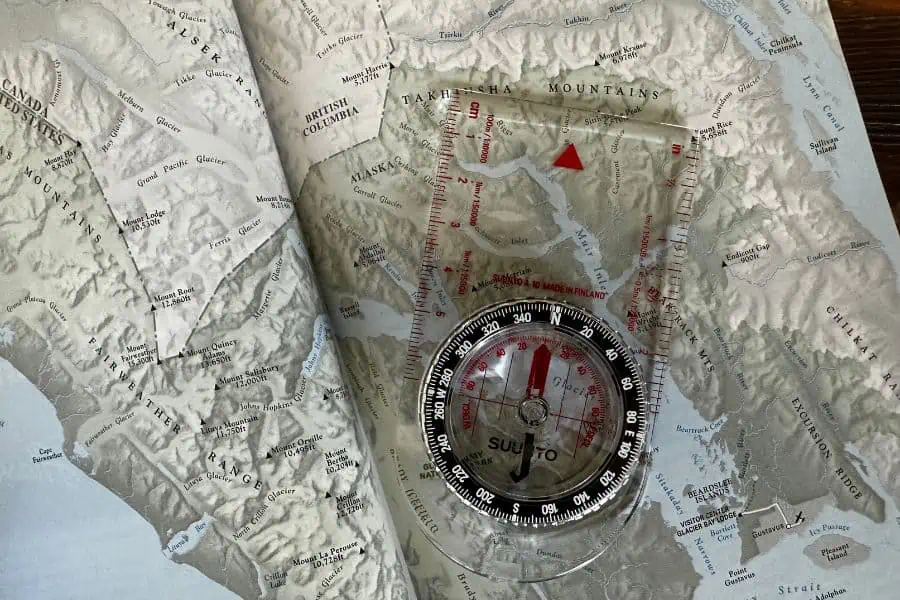
Head to any outdoor store, and you’re bound to find dozens of compasses available to you. Even in this article, there are five fantastic compasses that you have to choose from. So, how do you make that choice?
If you’re still on the fence, let’s go through a few factors that just might help you make up your mind.
Types of Compass
Now, there are actually three different types of compass typically used for hiking. In this section, I’ll give you a quick overview of each, to help you decide which one is better for you.
Basic Compass
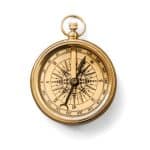
This term is typically used to refer to the classic, minimalistic pocket compass. These compasses have a needle that always points towards the magnetic pole, as well as markings indicating the four cardinal points: north, east, south, and west. And that’s about it.
A basic compass shows you which way to go, and that’s all. But in some cases, that’s more than enough to keep you in the right direction.
Sighting Compass
Now, sighting compasses are a bit more technical. They feature a foldable mirror lens, which allows you to look at whatever you’re taking a bearing from and your compass housing simultaneously. This type of compass is great for very precise navigation, and our pick for the best overall compass with the Suunto MC-2G Compass.
What’s more, a sighting compass also allows you to see the angle of inclination in front of you, which is especially useful when reading a topographic map.
Orienteering (Baseplate) Compasses
Finally, an orienteering compass is mainly designed to be used together with a map.
It’s lightweight and compact, so it’s suitable for backpacking, but it’s not as precise as a sighting compass is. Our favorite pick in this style is the A-10 NH from Suunto.
Glowing Indicators
If you’re like me and start your hikes early (to catch the beautiful sunrise), then investing in a glowing compass could be worthwhile.
On the other hand, I hear many nature enthusiasts complain that these phosphorescent compasses don’t glow bright enough. Their criticism is valid, but I have a quick workaround.
When my compass needs an extra charge to start lighting my way, I usually shine a high lumen flashlight on it for a few seconds, which does the trick. This method might be crude, but it gets my compass bright enough for me to read the directions in a snap.
Durability
When you spend money on any piece of hiking equipment, it should ideally have the durability to last you years. This is even more key when the item in question is responsible for safely getting you back to your campsite.
The A-10 NH from Suunto is a concrete example of reliable construction thanks to its jewel bearing and high-grade steel needle. The extra money you spend on buying something well-built is nothing compared to the hassle and risks of getting lost in the woods.
Liquid Freezing Point
Compasses that contain liquid are genuinely more accurate, but you have to be wary of its freezing point. Some liquid compasses are more susceptible to freezing, and this is absolutely unacceptable. A quality compass should read accurately, even in the most frigid temperatures.
So, check your compass’ freezing point before heading out to explore the tremendous Alaskan tundra or somewhere similarly cold.
I’ve personally experienced some fantastic trips that I would’ve never gone on if I avoided colder environments. Having gear that can stare low temperatures in the face without batting an eye gives you the freedom to explore further than you’d otherwise be able to.
Global Needles
Campers who only traverse a single hemisphere may not see the need for a so-called global needle. However, seasoned travelers and orienteering enthusiasts who travel all around the world will want the versatility of a worldwide compass.
There’s nothing wrong with products tailored to land navigation in the northern or southern hemisphere, as long as you know what you’re getting into. I also know some hikers who prefer to have two compasses — one for each hemisphere. Either way, be prepared and informed, and you’ll be fine with whatever setup you choose.
Adjustable Declination
Adjustable declination is a feature that only matters if you need precise compass navigation.
What is declination?
Put simply, it’s a calibration factor used to adjust for the difference between magnetic north and true north. For beginner travelers, this shouldn’t be too crucial. Still, rough and ready explorers should have this to keep their navigation precise.
For a detailed explanation, check out my ultimate guide on how to use a compass.
What are the different parts of a compass?
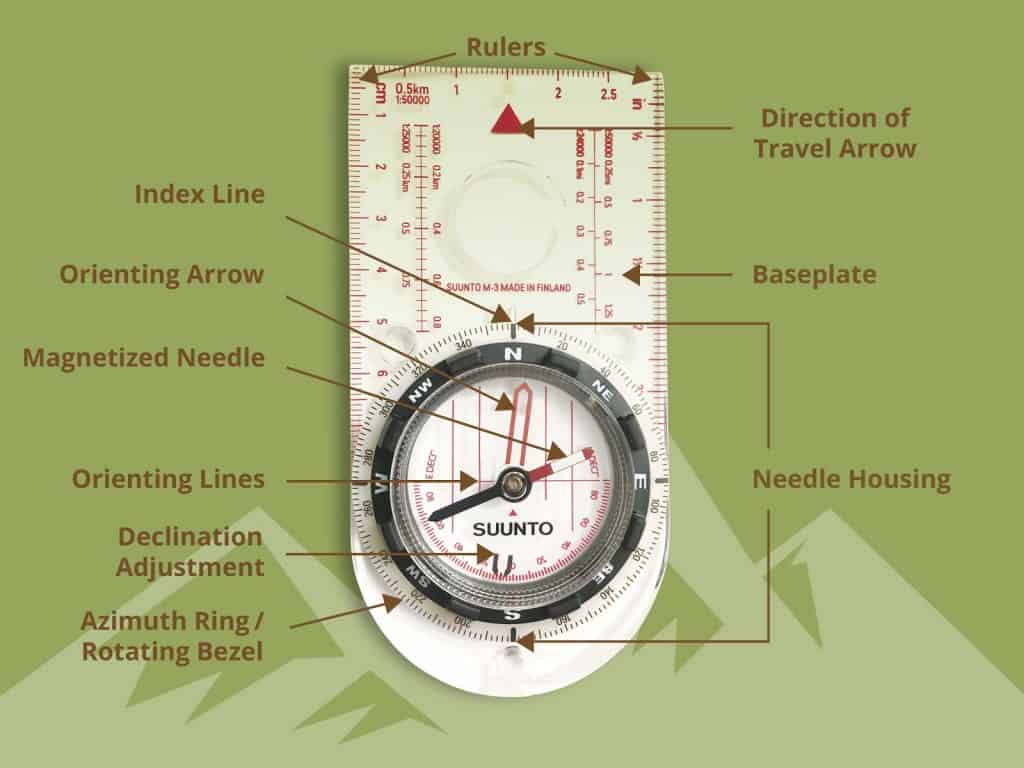
Now that you’ve checked out our recommended selection of compasses, it’s time to get comfortable with your compass and how it works.
Needle
First is the most important part – at least for us looking for directions – which is the needle. The magnetic needle is red in color and it’s always pointing toward the magnetic pole.
Housing
When we say housing, we’re referring to the whole thing containing the needle, orienting lines, and bezel (both of which I’ll address in a second), as well as the fluid added that steadies the movement of the magnetic needle.
Some models use air instead of fluid, but they’re not as common.
Baseplate
The baseplate of a compass is the clear plastic part to which the actual compass is attached.
Typically, the baseplate has straight edges that feature scales or rulers for easier orientation when using a map.
Bezel
Otherwise known as an azimuth ring, the bezel is the rotating ring on the outer edge of the housing.
It features a scale of 360 degrees, with the north representing 0 degrees.
Of course, the more expensive the compass, the finer increments it shows, so you can navigate more easily.
Orienting Lines
You probably noticed markings inside the housing of your compass.
These parallel lines rotate with the bezel and help you orientate more easily.
By aligning orienting lines with the north-south lines on a map, your orienting arrow will align with the north.
Orienting Arrow
The orienting arrow is used to orient the bezel, and it rotates as the dial is turned. You’ll notice it’s shaped just like the magnetic needle, but larger.
Direction-of-Travel Arrow
See that red arrow on the other side of the baseplate pointing upwards?
That’s the direction-of-travel arrow, which, as the name suggests, shows you the direction you should point the compass when following a bearing.
Index Line
The index line is located directly above the bezel, and it’s fixed on the outer edge of the compass housing.
Basically, the index line serves as an extension of the direction-of-travel arrow.
Magnifier
This one is pretty self-explanatory. Now, we all know how maps can be hard to read, especially if they’re considerably downscaled.
A built-in magnifier allows you to read the map more thoroughly, which is always a good thing to have.
Compass Scale
Last but not least, your compass has scales on the outer edge of the baseplate. These scales should make it easier for you to measure the distance on a map.
Compass Best Practices
Here are a couple of things to bear in mind once you own a compass:
Cautious Carrying
Be mindful of where you carry your compass. I’d advise against storing it in the same bag as electronic devices and metal tools to ensure it doesn’t get miscalibrated.
Using neck lanyards or keeping it in an exterior pocket is usually a safer bet.
Testing Alignments
You shouldn’t wait until you’re in the middle of a jungle to check if your compass readings are still accurate.
Test the calibration from time to time to see if your compass needs to be adjusted or even replaced. This will save you from getting into sticky situations.
Check For Bubbles
As I mentioned earlier, some compasses with liquid could have bubbles trapped inside the lens. This can impede the free movement of the compass needle, thus leading to inaccurate readings.
It’s best to return any unit with this problem and get a replacement from the seller.
Cleaning & Maintenance
Wiping down your compass after a stressful day of use can really extend its lifespan.
Get as much dirt and sand off the baseplate to keep all the measurements easily readable.
It only takes a minute or two to maintain your compass, but it’ll pay off in the long run.
FAQs
What is the most accurate compass?
Among the three types of compass, the most accurate one is a sighting compass. By being able to look at the object you are taking a bearing from and your compass housing at the same time, you can easily navigate even when using a topography map.
Do I really need a compass hiking?
Absolutely. Even though many trails are well trumped down and marked, you can easily get lost, especially when there aren’t any prominent details in your surroundings to use for navigation.
With a compass, you can find your way around even if you step away from the trail.
Is a liquid-filled compass better?
A liquid-filled compass is better because it allows a much freer movement of the needle.
However, different types of liquid are used for that purpose, and not all perform at the same level. Both oil and alcohol are a much better option than a water or oil-water mixture.
Are cheap compasses accurate?
A price tag is not a reliable indicator of the quality of a compass. Some models on our list are pretty affordable, yet they’re very accurate.
Is GPS more reliable than a compass?
A GPS will provide you with more detailed, exact directions compared to a compass, while it requires a lower level of navigational understanding. Plus, it’s generally easier to use.
However, it requires a strong signal to work properly and the batteries can run out, while the compass is available for use at all times.
Can you use your phone as a compass while hiking?
Yes, you can. Nowadays, there are many apps that allow you to turn your phone into a compass.
However, no app can be as precise as a compass. Plus, you depend on your phone’s battery.
How do you use a compass to not get lost?
You should always keep track of the direction of your destination, as well as periodically check your bearings, making sure you’re going in the intended direction.
Use the map as well, and take bearings from it.
Can a compass go wrong?
Our everyday items, including telephones, radios, GPS, cameras, avalanche transceivers, but also car keys, and belt fastenings, have magnets. And those magnets can interfere with the compass and even cause reversed polarity.
To avoid that from happening, keep these things away from your compass.
Our Verdict
We’ve looked at some truly impressive compasses throughout this article. I genuinely believe that there’s something for everyone when you look at all the options above. If you ask me personally, I’d say that the Suunto MC-2G is the best pick.
It’s portable, easy to use at night, and can stand up to magnetic interference without breaking a sweat.
There’s a reason it’s been in my EDC pack for years. It’s even Suunto’s longest-running model, which just goes to show how effective it’s been at serving consumers.
Ultimately, the MC-2G ticks most of the boxes, so there’s no reason not to get it.
Be sure to give your compass of choice some TLC to keep it in near-mint condition for years, or even decades to come.
Well, that’s all for now folks. Stay healthy, and keep hiking!





